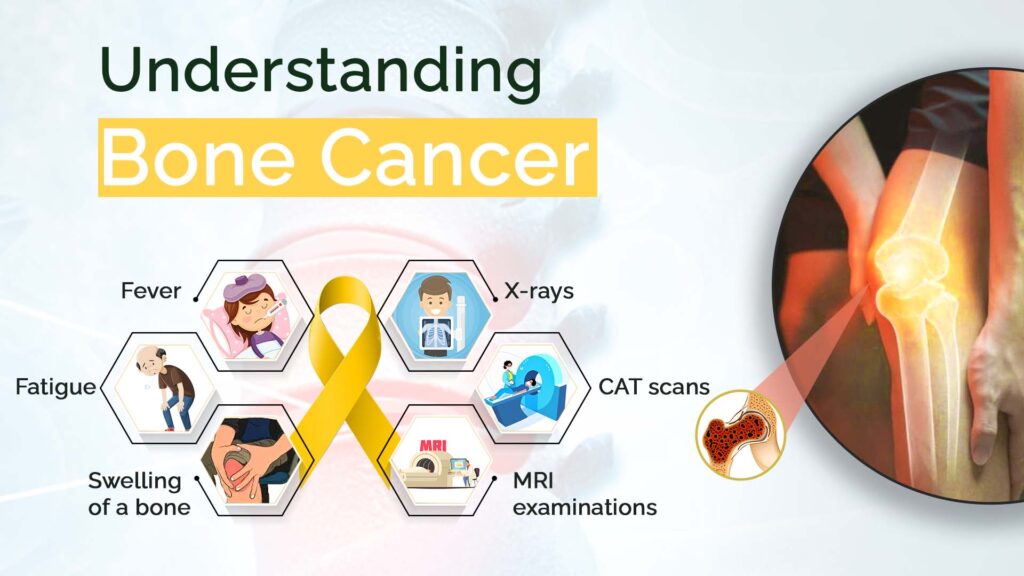Bone cancer occurs when abnormal cells in your bones multiply uncontrollably. It kills normal bone tissue. It may also begin in your bone or spread there from other parts of your body (called metastasis). The type of bone cancer is determined by the type of cell and tissue where cancer develops.
Bone cancer is quite uncommon. Most bone tumours are benign, which means they are not cancerous and do not spread to other parts of your body. However, they may still weaken your bones, leading to broken bones or other complications.
Benign or non-cancerous bone tumours
- The most typical type is Osteochondroma. It is common among people under the age of 20.
- Osteoid osteoma is most common in long bones, usually in your early twenties.
- Osteoblastoma is an uncommon tumour that develops in the spine and long bones, primarily in young people.
- Enchondroma is most commonly found in the bones of the hands and feet. It frequently lacks symptoms. It is the most prevalent type of hand tumour.
Types of Bone Cancer
Bone cancer is usually categorised into two types: Primary and secondary.
Primary Bone Cancer
Primary bone cancer, also known as bone sarcoma, is a malignant growth that begins in your bone. The following are some of the most prevalent kinds of primary bone cancer:
- Osteosarcoma: This cancer frequently develops around the knee and upper arm. It is most frequent in teenagers and young adults, while another type is common in people with Paget’s disease of bone.
- Ewing’s sarcoma: It is most common in children between the ages of 5 and 20. The most typical locations are your ribs, pelvis, leg, and upper arm. It may also begin in the soft tissue surrounding your bones.
- Chondrosarcoma: This is most common in adults between the ages of 40 and 70. This cancer, which develops in cartilage cells, is commonly seen in your hip, pelvis, leg, arm, and shoulder.
- Multiple myeloma: This is not a primary bone cancer, even though it occurs in the bones. It’s a malignancy of the marrow, which is the soft tissue inside the bones.
Secondary Bone Cancer
Secondary cancer is cancer in your bones that usually begins elsewhere in your body. For example, secondary bone cancer occurs when lung cancer spreads to your bones. Metastatic cancer refers to cancer that spreads from one place of the body to another.
Cancers that frequently spread to bone include:
Bone Cancer: How common is it?
Bone cancer is uncommon. They account for less than 1% of malignancies in the world. While they can occur at any age, they are more common in children, teenagers, and young adults than in older persons.
What should I know about the stage of bone cancer?
The size and location of the tumour, as well as whether or not the cancer has spread to other locations, determine cancer staging. There are four stages of primary bone cancer:
- Stage 1: The tumour is low grade, and the cancer cells have not spread. It’s just beginning.
- Stage 2: The cancer cells remain localised, but the tumour has advanced.
- Stage 3: The tumour is of high grade, and has spread to other parts of the bone.
- Stage 4: Cancer has moved from the bone to other parts of the body, such as the lungs or liver.
Risk Factors for Bone Cancer
The following factors may increase your risk of developing bone cancer:
- Cancer therapy. People who have received radiation, stem cell transplants, or certain chemotherapy medicines for other cancers are more likely to develop bone tumours.
- Conditions that are inherited. Diseases handed down through your genes, such as Li-Fraumeni syndrome and retinoblastoma, an eye cancer, can make you more prone to get bone cancer.
- Paget’s disease is a bone disease. This non-cancerous bone problem may also enhance your chances.
Symptoms of Bone Cancer
You may not notice symptoms of a bone tumour, whether cancerous or not. Your doctor may discover it when examining an X-ray of another condition, such as a sprain. However, symptoms can include pain that:
- Is in the tumour’s area
- Is aching and not dulling
- Worsens as time passes
Other signs of bone cancer include:
- Fevers
- Sweating at night
- Swelling of a bone
- Limping
- Fatigue
The Diagnosis of Bone Cancer
Your doctor will ask about your symptoms and medical history, and do a physical examination. They will examine images of your bones obtained through imaging tests such as:
- X-rays: These depict tumours and their sizes.
- CAT scans: X-rays are used by computers to create more detailed images.
- MRI examinations: These employ a powerful magnet to reveal what’s within your body.
- PET scanning: A technician will inject you with radioactive glucose (sugar). A scanner then identifies cancer cells, which consume more glucose than normal cells.
- Scanners for bones: A separate radioactive substance is injected into your vein by a technician. It builds up in your bones, where a scanner can detect it.
What is the prognosis for those suffering from bone cancer?
Bone cancer is successfully treated in many cases. Cancer never returns in these cases.
Other people with bone cancer may require additional treatments such as radiation therapy and chemotherapy to keep cancer from spreading. Many people with bone cancer get successfully treated and live fulfilling lives. Early-stage bone cancer patients have a better probability of complete recovery. Survival rates are lower when bone cancer is discovered later in life.
Some tips from Body Revival
Bone cancer is a rare type of cancer. Being diagnosed with the disease can cause anxiety, irritation, and uncertainty. Bone cancer can be successfully treated if diagnosed and treated early. You should also think about joining a cancer support group. Speaking with others who are going through similar experiences can be beneficial to your mental, and emotional, well-being.



























